Ready to go from total newbie to playing your first song on harmonica? We’re gonna do it in 7 simple steps, in your first harmonica lesson.
STEP 1 – Get the Right Harp
Look at your harmonica and make sure it has 10 holes.
Here’s what you don’t want:
❌ a harmonica with a button on the side (chromatic harmonica)
❌ a harmonica with more than 10 holes (tremolo harmonica)
❌ a harmonica whose label has any letter other than C
✅ Why? The 10-hole diatonic harmonica in the key of C is the easiest and most fun harmonica to learn to play, and all beginner lessons are on C harps.
If you’re super-bummed cos you’ve got the wrong kind or key of harp, thankfully harmonica is one of the cheapest instruments on the planet.
Regarding harmonica brands: I recommend getting something like a Lee Oskar or Hohner Special 20 if you can afford $40-$60. These harps are great for beginners and pro’s alike.
Or if you’re on a tight budget, the best cheap harmonica I’ve found is the East Top 008k which is in the $20 range.
For more info on brands check out my page Which Harmonica to Buy.
But you can’t play your harmonica right if you don’t hold it right…
STEP 2 – Hold the Harp Right
Most harps have numbers on top – make sure you have that side facing up so you have hole #1 on the left and hole #10 on the right.
If your harmonica doesn’t have numbers on the top cover plate just play one end and the other, and the hole with the lowest pitch should be on the left.
Some people make a big deal about how to hold the harmonica, but at this point it really doesn’t matter as long as you’re relaxed, comfy and there’s plenty of room for your lips.
Just pinching it on one or both sides is perfectly fine right now.
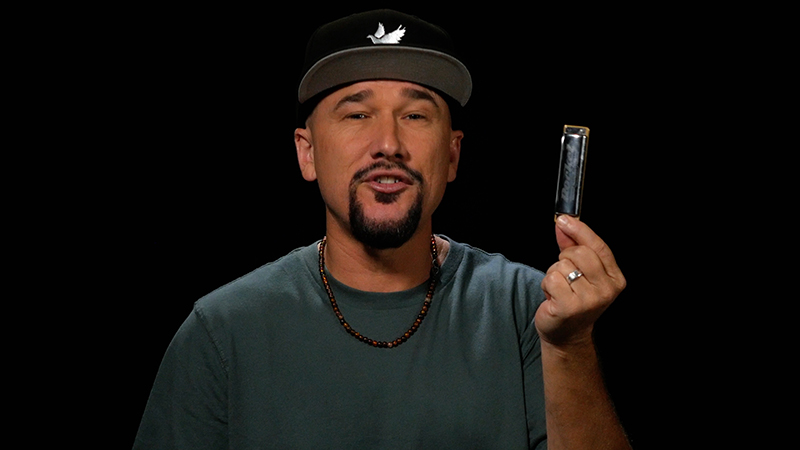
Here’s the most common way people hold the harp – extend your first finger and thumb to make a C shape and slide the harmonica in so it’s snug against the webbing.
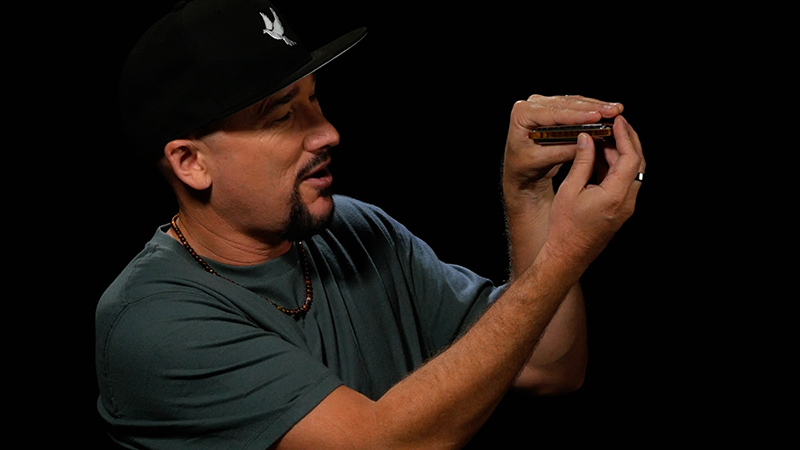
IMPORTANT: notice by holding the harp near the back, there’s plenty of room for the lips to be deep on the cover plate.
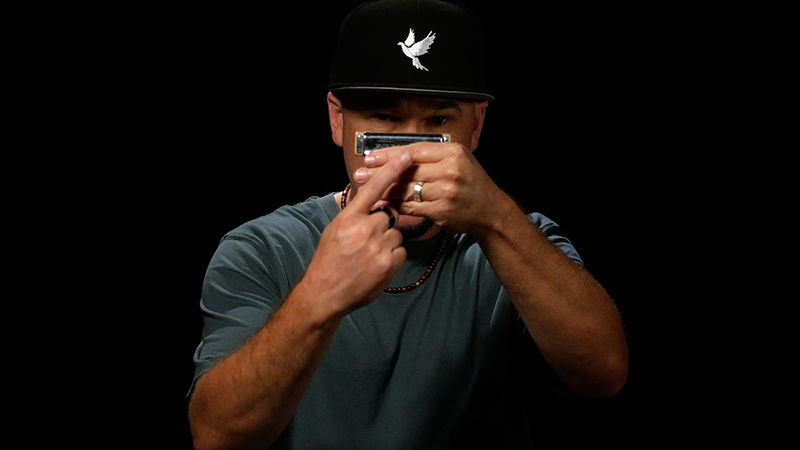
Some people feel that with 2 hands you have more control moving the harp left to right. On the other hand, playing with your shoulders hunched over all the time isn’t very good for your body.
So just play around with this and see what’s most comfy and fun for you.
If you do want to use 2 hands, here’s the traditional 2 hand grip:
➡️ Knife edge of palms together

➡️ Right hand pinky up one digit
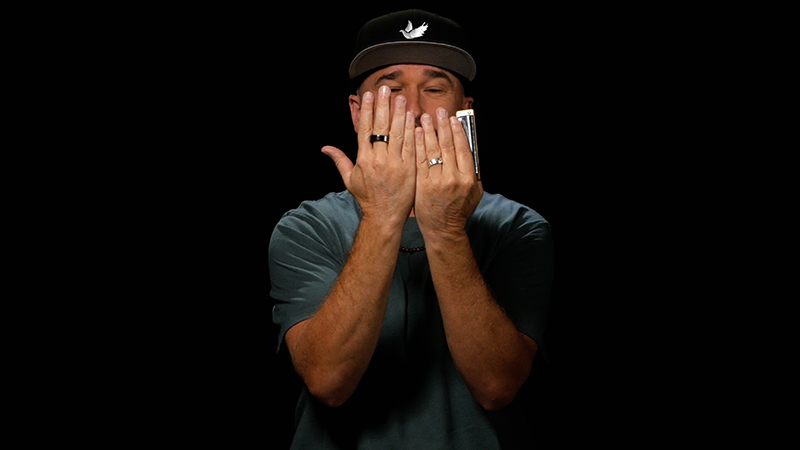
➡️ Left hand folds over so you’re looking at your letter C
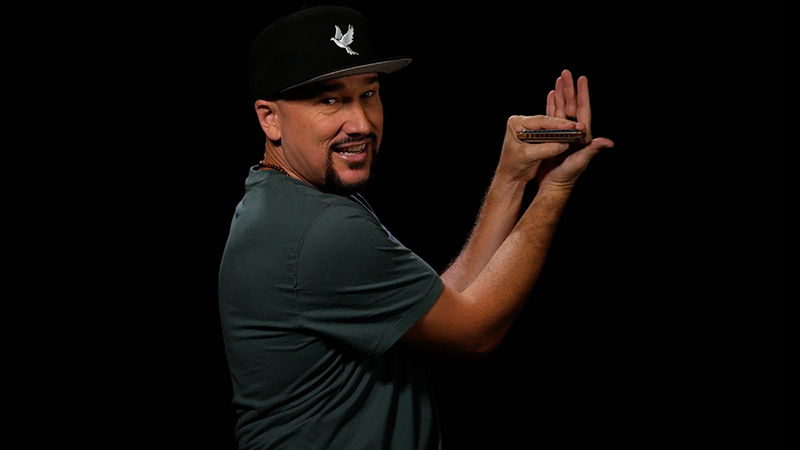
➡️ Right hand fingers fold on top
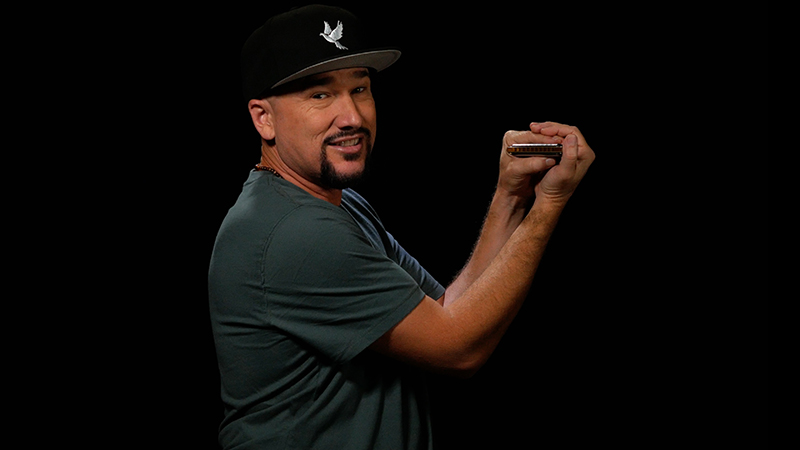
Notice the right thumb is on the side of the comb.
But again for right now it really doesn’t matter too much how you hold the harmonica. Even more important is how you breathe, your breath is the fuel for everything you’ll play…
STEP 3 – Learn How to Breathe
Here are 2 tips to breathe through your harmonica like a pro:
Tip 1: stand tall like a thread is pulling up on the back of your head, and look straight ahead. Why?
- By standing tall we create room for the diaphragm to move
- By looking straight ahead we keep our throat relaxed which is gonna give us great tone.
Playing in a bad position makes it hard to breathe, and when it comes to harmonica, breathing is everything.
Tip 2: practice deep diaphragmatic breathing by putting your hand on your lower belly – feel it go out as you breathe in and go in as you breathe out
The secret to breath control is Deep diaphragmatic breathing and it’s absolutely foundational to great harmonica playing – you can ask any pro player and they’ll tell you the same.
Most people breathe shallow in chest.
If you watch a baby you’ll see as they breathe in the belly goes out, and as they breathe out the belly goes in.
I’m not sure how or why so many of us get that reversed as adults, but getting our breathing right is absolutely fundamental to playing harmonica well.
This is how we want to practice breathing through the harmonica: in a CONTROLLED manner.
Most beginners heave into the harmonica. That excessive force:
👎 Creates terrible tone
👎 Causes reed to choke (make no sound)
👎 Over time makes reeds go out of tune, and eventually break
So we wanna breathe continuously like we’re blowing on a candle hard enough to move the flame, but not so hard as to blow it out. But that’s not the only mistake beginners make, puckering the lips is also a common mistake. What you need is…
STEP 4 – THE DEEP RELAXED MOUTH POSITION
The last thing you need to know before we rock hard on the harmonica is the Deep Relaxed Mouth Position. Deep relaxed mouth position is critical because without it you’ll never have great tone – no matter what you learn to play, you’ll sound like a hack.
The key here is we want our lips to look like a duck
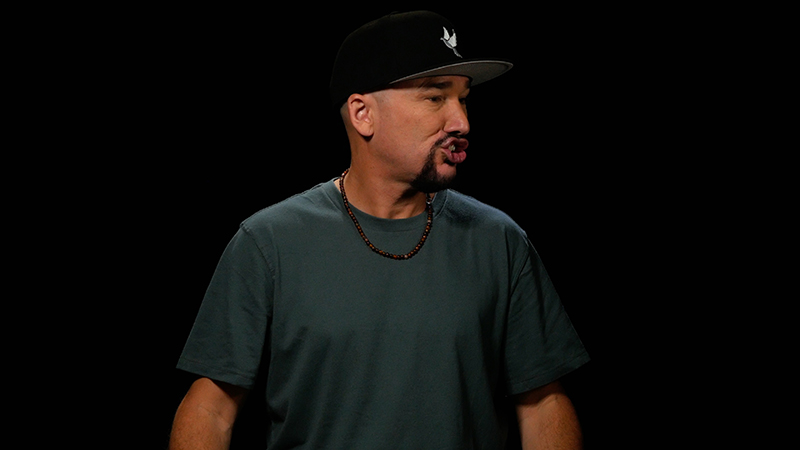
We don’t want our lips tense like when we peck grandma on the cheek.
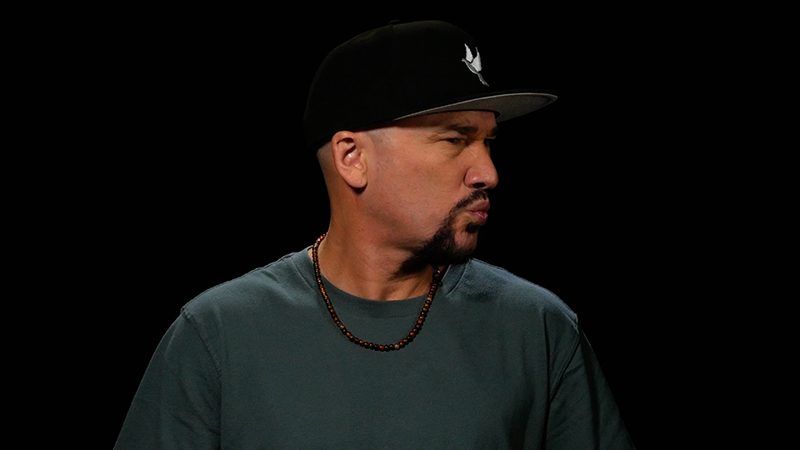
I’m gonna give you 5 fail-safe tips to ensure that you have the proper mouth position for that pro harmonica tone.
Tip 1: Hold the harmonica on the side. You can change your grip after learning this, but for now hold it on the side.

TIP 2: Moisten and relax the lips. It’s always good to have a glass of water, and you may need to use a little lip balm if you’re in a dry climate (just wipe down the harmonica with a clean, soft cloth when you’re done playing).
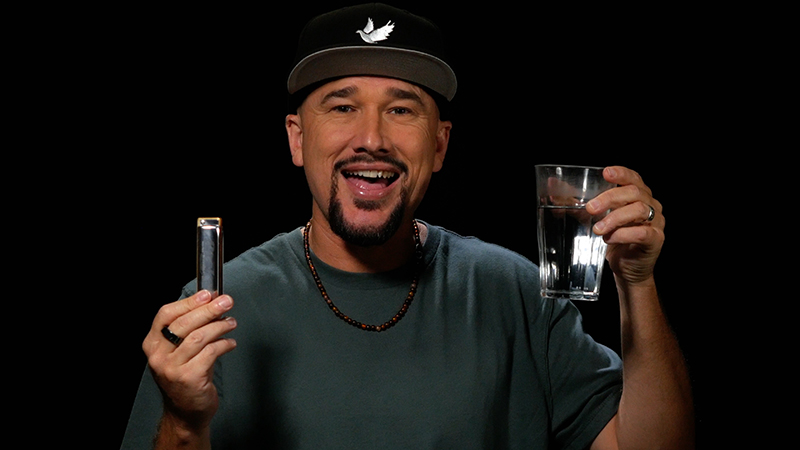
TIP 3: Put the harmonica in the mouth and rotate the back up toward ceiling so that the part inside your mouth goes deep into your lower lip.
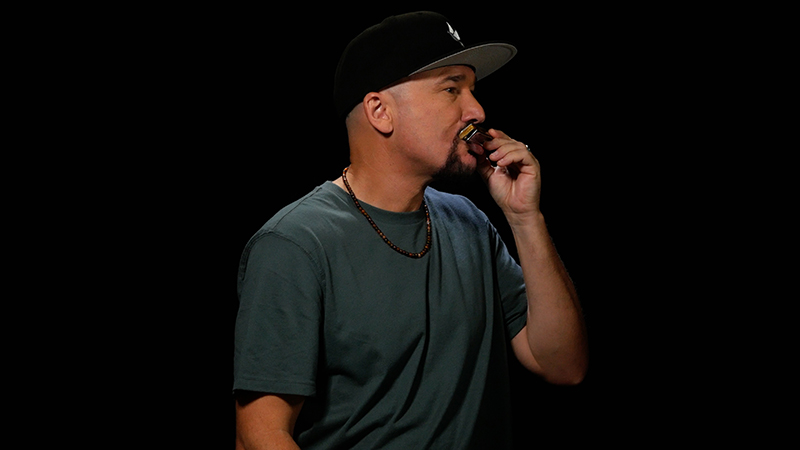
TIP 4: Look in the mirror or selfie mode and ensure the top lip is deep on the cover plate.
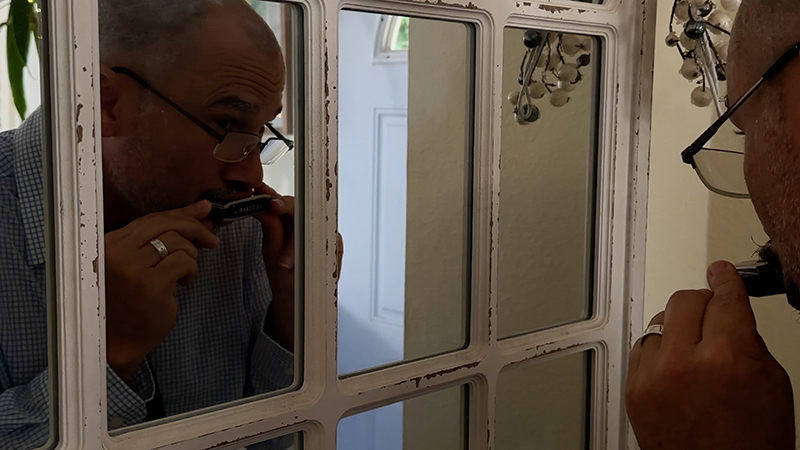
TIP 5: And this is the most important one: Confirm the bottom lip is untucked. If you have tense lips, you won’t be able to pull the bottom lip down.
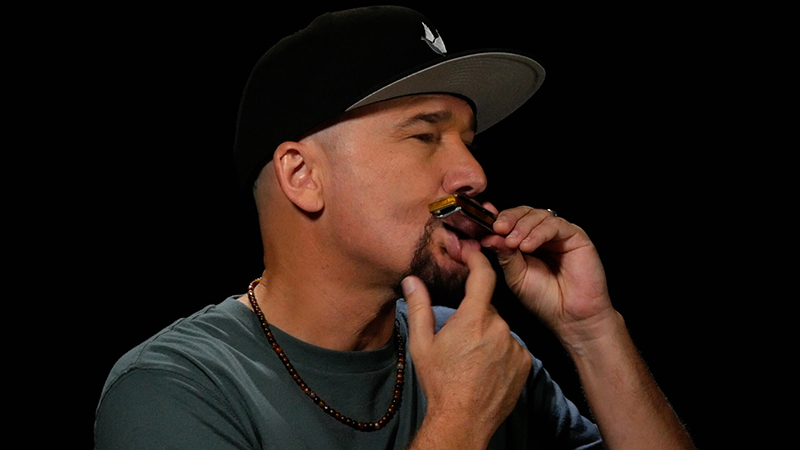
Here’s another way you can get to the right mouth position. Another name for the harmonica is the tin sandwich.
Take that name literally, and put the harmonica between your teeth.
Now pull it away slightly, and voila! you have the correct DRMP.
REMEMBER: If the moist inner portion of your lips is touching the harmonica, then you’re in great shape and you’re ready to start making music. And the best place to start is with simple chords…
STEP 5 – Playing Chords
There are basically just 2 chords on a C harmonica,
- Blowing anywhere produces a C chord
- Drawing between holes 1-4 is a G chord – if you wanna know more about that theory stuff, check out my lesson Chords for Beginners.
Our objective now is to gently breathe through the harmonica, with the deep diaphragmatic breathing and the deep relaxed mouth position.
Remember: Breathe, DON’T Heave.
We’re gonna breathe in for 4 counts and breathe out for 4 counts breathing in on holes- 123
Don’t forget that we aren’t WORKING harmonica, we’re PLAYING harmonica so remember to RELAX and have FUN.
STEP 6 – TONE & ARTICULATION
Music is sound, and the sound of that sound is TONE.
So in step 6 we’re going to learn how to shape tone with vowel shapes inside of our mouth, and I’m gonna introduce you to the harmonica player’s drumsticks that we can use to make people bob their heads and shake their tail feathers.
The reason I’ve shown you everything we’ve been through so far (posture, breathing, mouth position) is to facilitate GOOD TONE.
So you’re already on the right path. Now let’s explore the artistic tone-shaping options we have on the harmonica.
It’s hard to describe tone with words, but here’s the continuum of tone:
| Bass Side | Treble Side |
|---|---|
| Darker | Brighter |
| Warmer | More shrill |
| Rounder | Thinner |
| Fatter | Tinny |
| Duller | Icepick |
| Vowel Shape: UH | Vowel Shape: Ee |
The darkest, roundest tones are taller vowel shapes, “UH” or “OO” as in “book“.
The brightest icepick tone comes from wider vowel shapes, with the brightest being “EE”.
Try drawing and changing the vowel shape of your mouth.
We’re not actually saying (vocalising) the vowels but we are making those vowel shapes with our mouth as we breathe – kinda like whispering.
So that’s something we can always explore: changing the shape of our mouth to change the tone.
Now for articulation: the harmonica players drumsticks are Tuh Kuh.
- “T” is the tip of the tongue on the back of the top teeth
- “K” is back of the tongue touching of the roof of our mouth at a place called the hard palate
Now we are going to take our breathing and turn it into an actual groove – a basic train imitation which is one of the best technique builders on the harmonica.
The Train Groove
STEP 1: We’re gonna start by doing Tuh-Kuh breathing in, then Tuh-kuh breathing out, nice and slow.
STEP 2: Next, we’re gonna make our notes shorter, staccato is the musical term for it, so we’ll change it to tut-kut.
STEP 3: Slowly speed up our tempo.
STEP 4: The train whistle IS drawing anywhere above holes 1 and 2. (-34 or -345 or draw -45 will all work). Your goal with the train whistle is to make it sound as lonesome as possible.
You could try doing a hand wah if that’s appealing to you.
By the way, I teach all this stuff slowly and methodically in my Beginner to Boss course, so if you wanna turbocharge your growth on the harmonica, you can check that out here.
I also teach a ton of groove tricks in my course but let me get you started..
STEP 7 – GROOVE WITH THE MUSIC
The MOST important thing that separates the pros from the hacks is groove – locking in with the rest of the band so the music FEELS good.
I’m gonna show you 2 steps to make sure your playing is solidly grooving.
Any time you listen to music, there’s a pulse that you can bob your head or tap your foot to.
Feeling that pulse is step 1 to grooving with the band.
Each one of those pulses is called a “beat”. We name our rhythms after how many beats they last.
You could play a note that lasts 4 beats, which is called a whole note, 1 2 3 4, 1 2 3 4. In this example I’m inhaling in for 4 beats, and then exhaling for 4 beats:
You could play a note that lasts 2 beats, which we call a half note, 1 2 3 4, 1 2 3 4. In this example I’m inhaling in for 2 beats, and then exhaling for 2 beats:
You could play a note that lasts just 1 beat, which is called a quarter note, 1 2 3 4 1 2 3 4, In this example I’m inhaling and saying “Tuh” on beat 1 and “Kuh” on beat 2, and then exhaling and saying “Tuh” on beat 3 and “Kuh” on beat 4:
If you wanna get really fancy you could also play 2 notes per beat which are called 8th notes and we count those “1 & 2 & 3 & 4 &.” Here’s what this example looks and sounds like:
| BEAT | ACTION |
|---|---|
| 1 | inhaling and saying “Tuh” |
| & | inhaling and saying “Kuh” |
| 2 | exhaling and saying “Tuh” |
| & | exhaling and saying “Kuh” |
| 3 | inhaling and saying “Tuh” |
| & | inhaling and saying “Kuh” |
| 4 | exhaling and saying “Tuh” |
| & | exhaling and saying “Kuh” |
Things to notice about the 8th note pattern:
- We’re breathing in on beats 1 & 3, and breathing out on 2 & 4.
- We’re saying “Tuh” on the down beats (when we count numbers)
- We’re saying “Kuh” on the up beats (when we count “&”)
STEP 8 – SINGLE NOTES
One thing you’ll notice I haven’t addressed is playing single notes. That’s cos, if today’s your first day, I wouldn’t even worry about single notes.
Harmonica is unique in that learning how to isolate notes is a challenging technique.
You’ve learned A1 techniques today, and it takes time to get these important fundamentals down. That’s why in my Beginner to Boss course we do 28 chord lessons before we even get into isolating notes.
A sneak peek into playing single notes: we’re just gonna draw the corner of our lips together and allow our lips to go up and down, keeping them relaxed. RELAXATION is the key to everything.
If you feel that you’re ready to learn how to isolate notes, you can check out my lesson Single Notes for Beginners.
A lot of beginners think their -2 is broken. It’s not. If your -2 sounds like a dying duck, here’s the solution:
- The key here is to drop the jaw, and keep everything very relaxed.
- Lower the back of tongue like when you yawn, not when you say “Kk”.
- Don’t use too much pressure.
If today is your first day playing, then there’s a ton of great stuff you can work on without worrying about isolating notes.
Piano Man by Billy Joel is a great song for beginners to learn that doesn’t require single notes, and Heart of Gold by Neil Young is another one that’s lots of fun and doesn’t need single notes.
If you have any questions or comments please leave them below. I hope you never quit, and always keep playing the harmonica because it makes the world a better place!

Comments
Got something to say? Post a comment below.